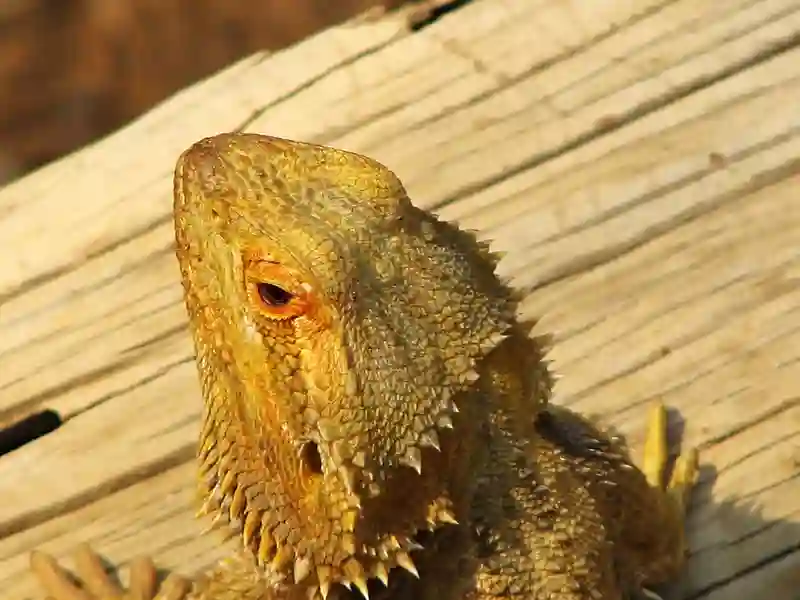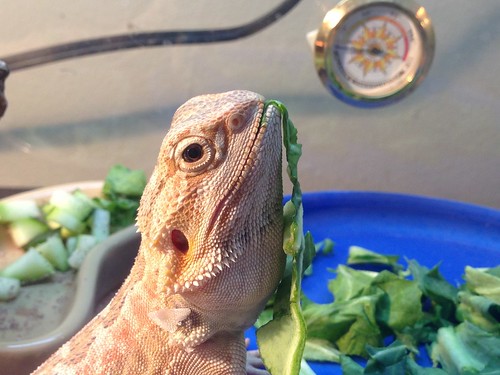Bearded dragon noses turn pink for lots of reasons. One possible reason is shedding. Shedding makes bearded dragons feel uncomfortable. Sometimes they will bulge their eyes out to help get rid of it. Pink noses can also happen when they shed.
There’s also a possibility that pink noses indicate respiratory problems, like pneumonia. If your bearded dragon is panting or has slimy, mucus-like discharge coming out of his mouth/nose, it could be a sign that his respiratory system isn’t working right.
The best thing to do in this case is to call a vet right away. A pink nose can also be caused by parasites, which cause prolonged diarrhea and lethargy, nose plugs that were left inside a bearded dragon’s nostrils from shedding, or snout rubbing, which happens when a bearded dragon’s enclosure is too small for it.
What Causes a Bearded Dragon’s Nose to Turn Pink?
Bearded dragons are fascinating reptiles that have become popular pets in recent years. While caring for them, owners may notice that their bearded dragon’s nose changes color. The most common reason for this is shedding and stress.
Shedding
Like all reptiles, bearded dragons shed their skin regularly. During shedding, the old layer of skin peels away, revealing new healthy skin underneath. This process takes around 7 to 14 days and can cause a bearded dragon’s nose to turn pink due to the skin becoming thinner as it prepares to shed.
Stress
Stress is another major factor that causes a bearded dragon’s nose to turn pink. There are several reasons why a bearded dragon may become stressed, such as an improper diet, incorrect temperatures in their habitat, or handling too much.
Different types of stress can cause different responses in your pet, including changes in their behavior or physical appearance like having a pink nose. If your dragon is stressed too much or for too long periods of time, it could result in more serious health problems and should be addressed immediately.
How to Identify and Alleviate Stress in Your Pet?
Identifying when your bearded dragon is stressed isn’t always easy but there are some signs you can look out for such as lack of appetite or lethargy. If you notice any sudden behaviour changes in your pet or they have not eaten for several days then they should visit the vet.
Alleviating stress can involve making minor adjustments like providing more hiding places within the enclosure and adjusting temperatures so they feel more comfortable. It’s important not to handle your pet excessively during times when they may already feel anxious or stressed out so you should avoid doing so until after they have returned back to normal behaviours.
Health Concerns Related to Pink Noses in Bearded Dragons
Bearded dragons are generally healthy animals and can live for many years when properly cared for. However, there are several health concerns that can lead to a pink nose in bearded dragons. Two of the most common health issues are respiratory infections and parasitic infections.
Respiratory Infections
Respiratory infections in bearded dragons are usually caused by bacteria or viruses. Common symptoms of respiratory infections include labored breathing, nasal discharge, wheezing, lethargy, loss of appetite, and a pink nose. These symptoms can indicate a serious infection that requires immediate medical attention from a veterinarian.
The causes of respiratory infections in bearded dragons include poor hygiene practices, low humidity levels in the enclosure, and exposure to other sick animals. Treatments for respiratory infections include antibiotics prescribed by a veterinarian along with proper hydration and warm temperatures in their enclosure.
Parasites
Parasitic infections are another common cause of pink noses in bearded dragons. They can occur when the reptile is exposed to contaminated food or water sources or through contact with other infected animals.
Symptoms of parasitic infection may vary from mild to severe and often include diarrhea, weight loss, loss of appetite, and lethargy. If you suspect your bearded dragon has a parasitic infection causing their pink nose it is important to take them to the veterinarian as soon as possible.
Treatment options might include antiparasitic medication prescribed by your veterinarian along with proper sanitation procedures for their environment. If you notice your bearded dragon’s nose turning pink it could be due to various health concerns including respiratory or parasitic infections.
It’s important to monitor your pet’s behavior closely for any changes that could indicate an underlying issue. When caught early enough most health issues facing these wonderful creatures can be treated effectively with professional veterinary care.
Proper Hydration
Bearded dragons require proper hydration to maintain good health and to keep their nose pink. It is important to note that these reptiles are not great drinkers and do not typically drink from a water dish. Instead, they get most of their moisture from their food.
However, it is still important to provide a shallow water dish in their enclosure, especially during warmer months when they may need extra hydration. A good way to encourage your bearded dragon to drink is by misting them with lukewarm water using a spray bottle.
Importance of hydration for bearded dragons
Adequate hydration for bearded dragons helps regulate body temperature, aids digestion, and assists in shedding. Lack of proper hydration can lead to dehydration which may cause severe health problems such as kidney failure or impaction.
How much water should they drink?
It is recommended that you mist your bearded dragon twice daily with lukewarm water and occasionally offer shallow dishes of fresh water throughout the day. The amount of water they need depends on several factors including age, size, diet, and environment.
Cleanliness
Maintaining cleanliness in your bearded dragon’s enclosure is essential for preventing bacterial infections that can affect the overall health of your pet. It is crucial to regularly clean the enclosure as well as any accessories or substrate.
How often should you clean your bearded dragon’s enclosure?
Cleaning the enclosure once or twice a week will suffice for adult dragons but juveniles will require more frequent cleaning as they have not yet mastered bowel control. Remove all feces and uneaten food daily using paper towels or tongs if necessary. Clean all surfaces with a diluted vinegar solution (one part vinegar mixed with three parts water) or mild soap solution then rinse well with warm water before setting up the habitat again.
What cleaning products are safe for your pet?
Avoid using harsh chemicals or bleach as they can be harmful to your pet. Instead, use a mild soapy solution or a diluted vinegar solution to clean the enclosure and accessories. Ensure that all surfaces are rinsed thoroughly before returning your pet to their habitat.
Conclusion
Bearded dragons are fascinating pets that require a lot of attention and care. A healthy nose is an important indicator of your pet’s overall health and well-being.
Shedding, stress, respiratory infections, and parasites can all cause a bearded dragon’s nose to turn pink. However, proper hydration and cleanliness can prevent many of these issues from occurring.
It is important to monitor your pet’s nose color regularly and seek veterinary care if you notice any changes or abnormalities. With proper care and attention, your bearded dragon can live a long and healthy life with a beautiful pink nose.
Summary of Key Points Made Throughout the Outline
Throughout this article, we explored the importance of maintaining a healthy nose in bearded dragons. We discussed the various causes of pink noses including shedding, stress, respiratory infections, and parasites. In addition to that, we also covered ways to keep your pet’s nose healthy such as through proper hydration & cleanliness.
Remember that owning any kind of pet comes with great responsibility and it is our duty as caretakers to ensure their wellbeing. By following the tips outlined in this article you will give your pet the best chance at living the best life possible!


